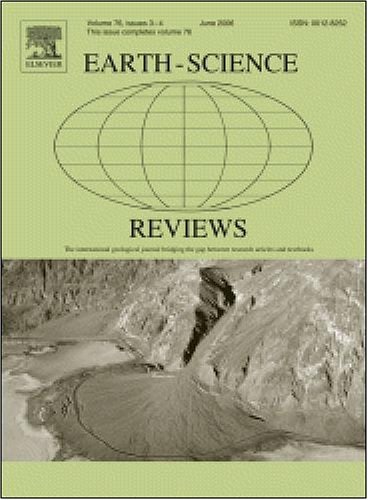Revisiting the Dom Feliciano Belt and surrounding areas – An integrated geophysical and isotope geology approach
IF 10
1区 地球科学
Q1 GEOSCIENCES, MULTIDISCIPLINARY
引用次数: 0
Abstract
The reconstruction of orogenic terranes across conjugate margins separated by oceanic formation requires the integration of complementary geological records from both regions. A major challenge lies in the loss of geological evidence following orogenic events, particularly processes associated with later continental break-up, such as those in southwestern Gondwana. In southeastern Brazil, Uruguay, and southwestern Africa, these records include Archean to Mesoproterozoic terranes and Pan-African-Brasiliano mobile belts. Following the amalgamation of the Gondwana supercontinent, these terranes underwent multiple phases of uplift, subsidence, and erosion, making their paleogeographic reconstruction more complex. To overcome these complexities, various datasets, including gamma-ray spectrometry, magnetic and gravity surveys, geological mapping, and U![]() Pb geochronology, were integrated. Our analysis reveals distinct geophysical domains and major lineaments defined by magnetic, gravimetric, and gamma-ray anomalies, providing new insights into the western Gondwana structural framework. The study highlights the collision between the Rio de la Plata Craton and the Congo and Kalahari cratons, characterized by thrust-and-fold belts and strike-slip systems. Distinct terranes are well-constrained, including the Rio de la Plata Craton, the São Gabriel magmatic arc, the Tijucas fold-and-thrust belt, and Ediacaran to Eopaleozoic terranes (Encruzilhada, Pelotas, and Punta del Este arcs), along with late to post-orogenic basins. Our refined mapping of terrane boundaries and shear zones enhances our understanding of tectonic evolution and supports correlations between terranes now separated by the South Atlantic. These findings improve interpretations of southwestern Gondwana's tectonostratigraphic architecture and its cratonic and orogenic assembly processes.
Pb geochronology, were integrated. Our analysis reveals distinct geophysical domains and major lineaments defined by magnetic, gravimetric, and gamma-ray anomalies, providing new insights into the western Gondwana structural framework. The study highlights the collision between the Rio de la Plata Craton and the Congo and Kalahari cratons, characterized by thrust-and-fold belts and strike-slip systems. Distinct terranes are well-constrained, including the Rio de la Plata Craton, the São Gabriel magmatic arc, the Tijucas fold-and-thrust belt, and Ediacaran to Eopaleozoic terranes (Encruzilhada, Pelotas, and Punta del Este arcs), along with late to post-orogenic basins. Our refined mapping of terrane boundaries and shear zones enhances our understanding of tectonic evolution and supports correlations between terranes now separated by the South Atlantic. These findings improve interpretations of southwestern Gondwana's tectonostratigraphic architecture and its cratonic and orogenic assembly processes.
重访Dom Feliciano带及其周边地区——综合地球物理和同位素地质方法
跨越大洋构造分隔的共轭边缘的造山地体的重建需要整合两个地区的互补地质记录。一个主要的挑战在于造山事件之后地质证据的丢失,特别是与后来的大陆分裂有关的过程,比如冈瓦纳西南部的那些。在巴西东南部、乌拉圭和非洲西南部,这些记录包括太古宙至中元古代地体和泛非-巴西利亚移动带。随着冈瓦纳超大陆的合并,这些地体经历了多个阶段的隆升、沉降和侵蚀,使得它们的古地理重建更加复杂。为了克服这些复杂性,他们整合了各种数据集,包括伽马射线能谱、磁力和重力测量、地质填图和UPb地质年代学。我们的分析揭示了不同的地球物理域和由磁、重力和伽马射线异常定义的主要轮廓,为冈瓦纳西部构造框架提供了新的见解。研究强调了里约热内卢de la Plata克拉通与刚果克拉通和喀拉哈里克拉通的碰撞,以逆冲褶皱带和走滑系统为特征。不同的地体受到很好的约束,包括里约热内卢de la Plata克拉通、s o Gabriel岩浆弧、Tijucas褶皱冲断带、埃迪卡拉纪至上古生代地体(Encruzilhada、Pelotas和Punta del Este弧)以及晚至后造山盆地。我们对地体边界和剪切带的精细绘制增强了我们对构造演化的理解,并支持了现在被南大西洋分开的地体之间的相关性。这些发现改善了对冈瓦纳西南部构造地层结构及其克拉通和造山组合过程的解释。
本文章由计算机程序翻译,如有差异,请以英文原文为准。
求助全文
约1分钟内获得全文
求助全文
来源期刊

Earth-Science Reviews
地学-地球科学综合
CiteScore
21.70
自引率
5.80%
发文量
294
审稿时长
15.1 weeks
期刊介绍:
Covering a much wider field than the usual specialist journals, Earth Science Reviews publishes review articles dealing with all aspects of Earth Sciences, and is an important vehicle for allowing readers to see their particular interest related to the Earth Sciences as a whole.
 求助内容:
求助内容: 应助结果提醒方式:
应助结果提醒方式:


